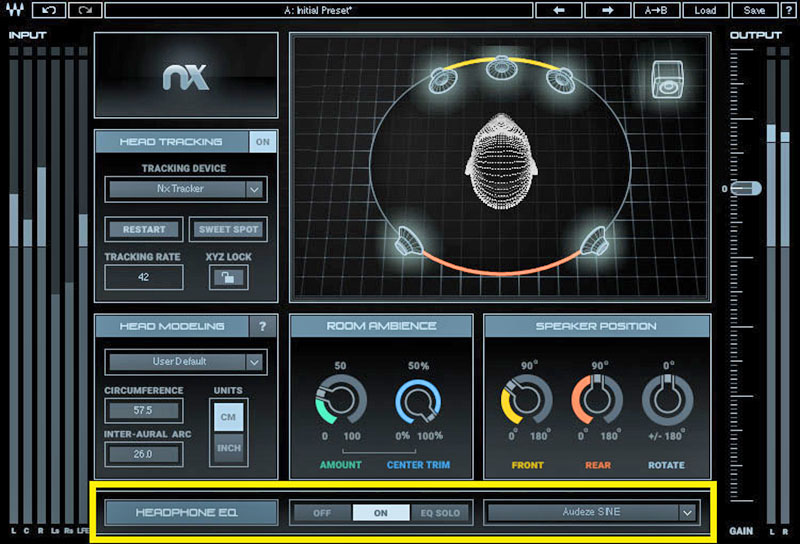

The physical impact of sound waves, particularly in the bass range, has been emulated but never perfected. Headphones will never replace a good studio environment. The idea of NX is interesting on paper, but even better in practice. However, using one of these plug-ins on its own wasn't really acceptable: if you've got a really high-end pair of headphones, you might be able to get by without the Soundworks frequency corrector, but the NX really changed the sound from a dead, neutral environment to something which felt like you could work in it permanently and with lower ear fatigue. Even the difference between the sound of the Waves RCompressor being switched on or off with neutral settings was readily apparent. EQing hi-hats and kick drum compression became more surgical and accurate and the difference in small parameter changes was much clearer. I had a listen to a few rough mixes and found that issues with muddiness and impact jumped right out and begged to be corrected, whereas before, they seemed passable. The difference when using the NX in conjunction with the Sonarworks frequency corrector was eye-opening and made me feel like I couldn't reasonably monitor from my studio in its current state. My own project studio has a pair of KRK RP6's with broadband bass-trapping and reflection dampeners, so I've put some effort into the sound but it's hardly a flawless environment. Using both plug-ins at once makes for quite a large CPU hit, and you'll need to remember to switch them off before bouncing any audio out of your DAW. NX isn't a frequency-flattening application, so depending on the quality of your cans, you might want to use it together with a tool like Sonarworks' headphone calibration plug-in-however, a Waves representative on the Gearslutz forum indicated that frequency-flattening is in development. I'll be looking forward to trying NX with the upcoming Head Tracker unit, which clips on to your headphones and should solve these problems. The tracking can struggle in low light, so those who prefer a darker studio will need to brighten things up, and it'll also cut out if you turn your head at too great an angle or move about the room. Some people might want to turn this feature off and stay in the virtual sweet spot regardless of your head's position, but personally I found that the head-tracking gave a much more natural feel and, after a while, it felt weird without it.
#Waves nx review software#
Using a webcam, the software maps the features on your face and follows your head movements, changing the sound as if you were turning your head relative to the speakers in front of you. The most characteristic feature is the head-tracking. It also offers 5.0 and 5.1 surround sound options for those mixing down to multiple channels. Rather than emulating different environments, NX models a single optimum mix space, so after watching the five-minute quickstart video you'll be up and running in no time. Switching the plug-in on, there's a significant difference compared with a dry signal, with a rich feeling of depth and stereo space. Waves are one of the most respected plug-in companies in the game, and their expertise is evident in the NX's sound.

If you want to get really serious, there's also the SPL Phonitor 2, which combines loudspeaker simulation with a high-quality headphone preamp for around £1000. The first is more straightforward than the NX and the latter somewhat more involved in that it replicates a variety of different listening environments and monitors. There are a few other plug-ins on the market that try to replicate this already, like the 112dB Redline Monitor or the Focusrite VRM box. In a real-world listening environment, your left ear would hear some signal from the right speaker, both of your ears would hear reflections from the walls, floor and ceiling, and you'd also hear sound that has passed through your head. It uses a model of an ideal control room and the position of your head, ears and body to change the master stereo signal from a left-right output to one where each channel contains information from both channels and their interaction with the virtual room around you. Some plug-ins measure room character and adjust the frequency response of your monitors, where others use psychoacoustic techniques to imitate a three-dimensional, physical space in headphones. There are a growing number of solutions to deal with this. Some people are forced to use headphones for noise reasons, others might travel a lot and produce on the move, and many have studios in a bedroom or poor acoustic space where sound treatment is either impractical or feels like a battle against the odds. It largely comes down to your personal circumstances. The question of monitoring on headphones is one of music technology's most fierce and subjective debates.


 0 kommentar(er)
0 kommentar(er)
